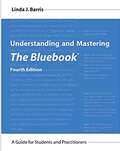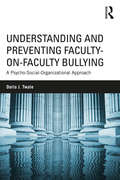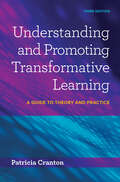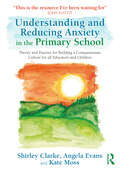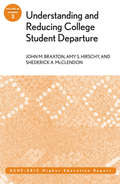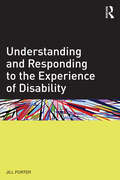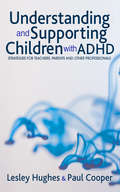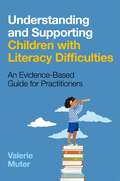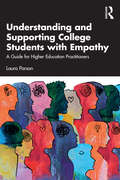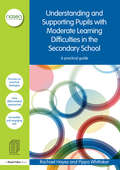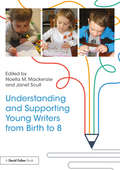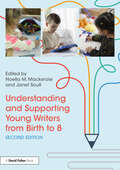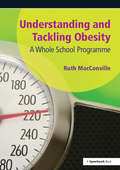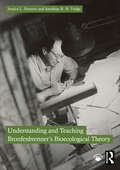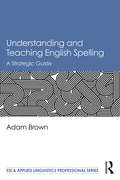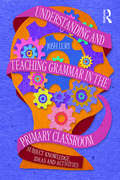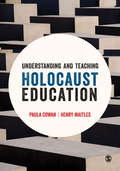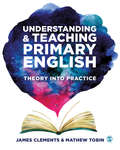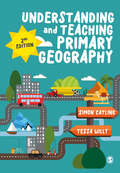- Table View
- List View
Understanding and Mastering The Bluebook: A Guide for Students and Practitioners
by Linda J. BarrisThe Bluebook® provides the rules for legal citation, but can be intimidating and frustrating to use. With its simple building-block approach, this survival manual teaches how to understand and master the essential rules for legal practitioners. Rules are fully described and illustrated using: Clear explanations and illustrations of the basic components of legal citations; Step-by-step instructions for building citations to the most common authorities cited by legal practitioners; Detailed guidance for citing legal materials to both print and electronic sources; Examples, comparison charts, illustrations, and bullet-point explanations designed for quick mastery of basic Bluebook citation rules; Tips, hints, and cautions to help users avoid common citation errors; Cross references to the controlling Bluebook rules; and A user-friendly format gathering The Bluebook's scattered rules for each authority into one place. For readers interested in further practicing their citation skills, Linda Barris created Mastering The Bluebook Interactive Exercises, an online learning tool. The new edition will coordinate with both Understanding and Mastering The Bluebook, Fourth Edition and The Bluebook, 21st Edition (both out summer 2020). Each copy of Understanding and Mastering The Bluebook, Fourth Edition includes a discount code for 20% off the purchase of Mastering The Bluebook Interactive Exercises.
Understanding and Preventing Faculty-on-Faculty Bullying: A Psycho-Social-Organizational Approach
by Darla J. TwaleUnderstanding and Preventing Faculty-on-Faculty Bullying provides a comprehensive understanding of workplace harassment, aggression, violence, bullying, and incivility in academia. Using a psychological, sociological, and organizational approach, this book explores the issue from the perspective of the individual, the department, and from the higher education organization. Providing research on the effects on victims and collegial culture, this important volume brings together interdisciplinary scholarship to present research-based suggestions for recovering from workplace bullying, recommendations for improving toxic academic environments, and practical advice about policy development to improve academic organizational culture and climate.
Understanding and Promoting Access for People with Learning Difficulties: Seeing the Opportunities and Challenges of Risk
by Melanie Nind Jane SealeThe issue of access is at the forefront of the practical challenges facing people with learning difficulties and people working with or supporting them. This engaging text brings together evidence, narratives and discussions that question and advance our understanding of the concept of access for people with learning difficulties. Seale and Nind draw on their expertise to analyse a wide range of situations, including access to public spaces, citizenship education, community participation, and employment. Through a series of related chapters, key researchers in the field of inclusion and learning difficulties enrich the access debate by: considering what kind of access people with learning difficulties want; identifying effective practice in relation to facilitating and promoting access; revealing the capability of people with learning difficulties to seek and achieve access to potentially exclusionary communities; providing a space for a wide range of people to share access stories. With contributions from a variety of stakeholders including people with learning difficulties, Understanding and Promoting Access for People with Learning Difficulties clarifies the concept of access without over-simplifying what is involved. Through rigorous critique, this book provides a unique rationale for a new multi-dimensional model of access and ways of promoting it. Proposing a reconceptualisation of the risk associated with promoting access for people with learning difficulties, this book will be of immense interest to students, researchers and professionals involved in inclusion and disability issues.
Understanding and Promoting Transformative Learning: A Guide to Theory and Practice
by Patricia CrantonThe third edition of Patricia Cranton’s Understanding and Promoting Transformative Learning brings a wealth of new insight from the tremendous growth in the field during the decade since the previous edition. As in the previous editions, the book helps adult educators understand what transformative learning is, distinguish it from other forms of learning, and foster it in their practice. The first part of the book is dedicated to clarifying transformative learning theory and relating it to other theoretical frameworks. The author examines transformative learning from the learner’s perspective, and discusses individual differences in how learners go through the process. In the second half of the book, the focus is squarely on strategies for promoting transformative learning in a wide variety of adult and higher education contexts. Practitioners will be able to take ideas from the text and apply them directly in their teaching.Since 1975, transformative learning has become a core theoretical perspective in adult and higher education, and research has proliferated. In the past decade, adult education and especially transformative learning grew into a noticeably larger field. The numbers of undergraduate and graduate programs in adult education have increased and continue to increase as more and more individuals are seeking the expertise, skills, and training necessary to work with adult learners in higher education, business, industry, government, health professions, non-profit organizations, and community development. In addition, the number of programs in higher education (both undergraduate and graduate) that include courses in transformative learning has grown dramatically. These academic audiences use the book to further their understanding of transformative learning theory and practice.Drawing on the latest research as well as the author’s own teaching experience in both online and face-to-face courses, this new edition will be a vital resource for members of the transformative learning community, as well as those encountering the topic for the first time.
Understanding and Reducing Anxiety in the Primary School: Theory and Practice for Building a Compassionate Culture for All Educators and Children
by Shirley Clarke Kate Moss Angela EvansEveryone working in education, and beyond, is fully aware of the current mental health crisis for pupils. Understanding and Reducing Anxiety in the Primary School combines the expert knowledge of a specialist in formative assessment, a child and adolescent psychotherapist and an outstanding headteacher to address how we may tackle this issue and improve the wellbeing of children in our schools. Formative assessment, one of the key techniques explored within this book, has explicit links with reducing anxiety: raising children’s belief in their ability to achieve and giving them clear frameworks of learning intentions and success criteria as well as in-the-moment feedback so that they are reassured and able to voice any worries while they are working.Written in a practical and accessible manner, the authors unpack the psychology behind issues related to students’ mental health and provide illustrative, relatable anecdotes and helpful strategies to support a positive, anxiety-free learning environment.The book is divided into four distinct sections: Why is everyone so anxious and what can we do about it? Understanding and dealing with extreme behaviour Supporting the learning to reduce anxiety Creating a containing and compassionate school This is a must read for anyone working in a primary school. Readers will benefit from learning strategies to reduce the anxiety of the children they work with and to support the wellbeing of the wider educational community.
Understanding and Reducing College Student Departure
by John M. Braxton Amy S. Hirschy Shederick A. McclendonStudent departure is a long-standing problem to colleges and universities. Approximately 45 percent of students enrolled in two-year colleges depart during their first year, and approximately one out of four students departs from a four-year college or university. The authors advance a serious revision of Tinto's popular interactionalist theory to account for student departure, and they postulate a theory of student departure in commuter colleges and universities. This volume delves into the literature to describe exemplary campus-based programs designed to reduce student departure. It emphasizes the importance of addressing student departure through a multidisciplinary approach, engaging the whole campus. It proposes new models for nonresidential students and students from diverse backgrounds, and suggests directions for further research. Academic and student affairs administrators seeking research-based approaches to understanding and reducing student departure will profit from reading this volume. Scholars of the college student experience will also find it valuable in defining new thrusts in research on the student departure process.
Understanding and Responding to the Experience of Disability
by Jill PorterUnderstanding and Responding to the Experience of Disability informs readers about current understandings of disability and ways of recognizing the needs that arise from the lived experience of impairment in schools. While most schools have clear procedures in place with respect to identifying children with special educational needs, the same is not true for disability. Moreover, research suggests that many schools have restricted understanding of this distinction, often equating disability to children with SEN and children with health conditions, thereby failing to recognize the pivotal role of impact. In this insightful text, Jill Porter argues that disability needs to be understood within the setting in which it is experienced, thereby recognizing that it is not a fixed attributable label, but one that is cultural, contextual and fluid. By providing a theoretical basis for understandings of disability around notions of impairment, experience and impact, the book combines three key components: a conceptual understanding of disability – to provide a clear value driven framework for professional responses; an empirical illustration of the development of materials to support an understanding of why the process of disability data collection cannot simply be reduced to two questions on a form; embedded illustrative case study material to provide exemplars of how the materials can be contextualized and used to make adjustments to enhance the participation of all children.
Understanding and Supporting Children with ADHD: Strategies for Teachers, Parents and Other Professionals
by Lesley A Hughes Paul W Cooper′This book provides a succinct overview of issues relevant to understanding and supporting pupils with ADHD. It is well written and includes authentic case studies... The real strength of the book is in its careful consideration of how collaborative working can enable youngsters with an ADHD diagnosis to get the best out of their education. Ideas outlined are practical but are also based on careful thinking about effective models and approaches to intervention... an excellent starting point for anyone embarking on research related to educational provision for pupils with ADHD′ - SENCO Update ′In many ways this publication reads like a toolkit, and as such offers a range of practices that may be considered in order to improve outcomes for all. A readable and supportive book′ - SNIP Children with Attention Deficit Hyperactivity Disorder (ADHD) can be hard to include in a mainstream classroom, and managing their behaviour is often a challenge. Drawing directly from real classroom experience, this book shows how to use effective management strategies to improve behaviour in the classroom and at home. This interdisciplinary approach will provide teachers with: " strategies to deal with disruptive behaviours " ways to channel children′s positive characteristics " advice on how teachers can support and guide parents " behaviour management techniques to promote positive behaviour " advice on collaborative working, and how teachers can build partnerships with other professionals.
Understanding and Supporting Children with Literacy Difficulties: An Evidence-Based Guide for Practitioners
by Valerie MuterLearning to read is arguably the single most important educational challenge a child faces in the first years of schooling, setting a child up for future academic success and opportunities. However, it is estimated that one in six children experience literacy difficulties. This is the go-to book for psychologists, educationalists and other professionals wanting a deeper understanding of current thinking around dyslexia, reading comprehension difficulties, and related SpLDs. Drawing on six fictional case studies to illustrate her points, and using examples of good practice throughout, Valerie Muter unpacks the latest psychological theories and research on literacy disorders. She discusses the interconnections between underlying cognitive problems and learning and educational and behavioural issues, as well as the common co-occurrence of these conditions. This authoritative book also provides accessible guidance on making assessments and tailoring interventions within the home or school.Written by a lead thinker in the field, this is an essential evidence-based guide for those working with children with literacy difficulties and supporting them to achieve their full potential.
Understanding and Supporting College Students with Empathy: A Guide for Higher Education Practitioners
by Laura ParsonThis practical book shares the tools and processes that higher education professionals can take to develop empathy and perspective-taking. Guided by a framework for developing empathy, each chapter describes how to implement empathy and perspective-taking in the key domains of practice: self, students, colleagues, and social justice. Ultimately, the book discusses how empathy and perspective-taking can promote student success, holistic well-being, and positive change in college and university settings. Each chapter is supported by real-world examples and strategies for higher education practice. This is a must-read for those working with college and university students—especially for those with students who have identities and backgrounds different than their own—to develop the skills needed to support themselves, their students, and their colleagues.
Understanding and Supporting Pupils with Moderate Learning Difficulties in the Secondary School: A practical guide (nasen spotlight)
by Rachael Hayes Pippa WhittakerAre you working with students who have Moderate Learning Difficulties? Do you want to know how best to help them? Are you confused about what helps and what hinders? Learners with MLD form one of the largest categories of special educational need in mainstream secondary schools. In most schools, the vast majority of learners with MLD will be taught in mainstream classes much of the time. This book outlines a range of strategies and approaches for supporting these learners. It includes all the vital information practitioners need to know about Moderate Learning Difficulties. Key points covered include: Definitions and identification of moderate learning difficulties Teaching strategies and approaches Developing key conceptual, literacy and social skills Effective support from TAs Theoretical perspectives on learning Understanding and Supporting Pupils with Moderate Learning Difficulties in the Secondary School provides an introduction to a wide range of ideas, arguments and perspectives about ways of understanding and supporting learners who are considered to have MLD. This is a much-needed source of knowledge for teachers, TAs, SENCos, Learning Mentors and anyone who supports children and young people with moderate learning difficulties and provides an honest and accessible approach.
Understanding and Supporting Young Writers from Birth to 8
by Noella Mackenzie Janet ScullAs the world comes to grips with what it means to be literate in the twenty-first century, Understanding and Supporting Young Writers from Birth to 8 provides practitioners with the skills and knowledge they need to support young children effectively as they learn to write. Interweaving theory and research with everyday practice, the book offers guidance on all aspects of writing, from creating multimodal texts and building children’s vocabulary, to providing support for children who find writing particularly challenging. With appropriate strategies to develop young children’s writing from an early age included throughout, the book discusses the role of oral language in early writing in detail and explores the key relationships between ‘drawing and talking’, ‘drawing and writing’ and ‘drawing, talking and writing’. Each chapter also features samples of writing and drawing to illustrate key points, as well as reflective questions to help the reader apply ideas in their own settings. Further topics covered include: progressions in children’s writing writing in the pre-school years developing authorial skills developing editorial skills teaching writing to EAL learners. Understanding and Supporting Young Writers from Birth to 8 is a unique resource that will help early childhood educators, early years school teachers, specialist practitioners working with very young children, and students enrolled in Early Childhood or Primary Studies courses to boost their confidence in teaching young learners as they become writers.
Understanding and Supporting Young Writers from Birth to 8
by Janet Scull Noella M. MackenzieUnderstanding and Supporting Young Writers from Birth to 8 provides practitioners with the knowledge and skills they need to support young children as they learn to write. This fully updated second edition offers new guidance on all aspects of writing, from building children’s vocabulary and creating multimodal texts to providing support for children who find writing particularly challenging. All chapters have been revised and updated with increased emphasis on engaging with families and catering for children from diverse communities. A new chapter focuses on the Draw, Talk, Write, Share (DTWS) pedagogical approach to teaching writing.The book discusses the role of oral language in early mark-making and writing in detail and explores the key relationships between "drawing and talking," "drawing and writing," and "drawing, talking, and writing." Each chapter also features practical strategies and samples of writing and/or drawing to illustrate key points, as well as reflective questions to help the reader apply the ideas to their own setting. Further topics covered include: progressions in children’s writing writing in the pre-school years developing authorial skills developing phonological awareness, phonics, and spelling handwriting and keyboarding skills teaching writing to plurilingual learners assessing writing Understanding and Supporting Young Writers from Birth to 8 is a contemporary and unique resource that will help early childhood educators, early years schoolteachers, specialist practitioners working with very young children, and students enrolled in Early Childhood or Primary Studies courses to boost their confidence in teaching young learners as they become writers.
Understanding and Tackling Obesity: A Whole-School Guide
by Ruth MacConvilleFrom an early age children are bombarded by the media with messages promoting foods high in saturated fats, sugars and salt. One of the greatest changes for children in the last 50 years is the decrease in exercise and the increase in 'screen' time. This programme is not about dieting or weight control, instead it has been designed to be realistic and non-discriminatory, aiming to enable children from an early age to recognise and resist unhealthy pressures, maintain body-esteem and know how to make skilled choices that will ensure their health and wellbeing. 'When we shift the focus from fat and weight to healthy choices leading to nutritional health and fitness we sacrifice nothing and gain an approach that enhances the wellbeing of all.' (Kater, 2005). The 12 sessions cover topics including: what to eat; how to understand food labels; media messages; get moving; and TV turnoff. There are full facilitator notes with all the necessary resources to run an interactive programme that will engage children. Supporting the class activities there are 'take home' activities that will keep parents aware of what is being covered in the programme as well as a weekly log, where children record trying new foods and physical activities. The book contains background information about the increase in obesity, the effect of media messages as well as the philosophy and approach taken in the programme. The package includes a CD-ROM which has all the copiable resources and a PowerPoint for staff training.
Understanding and Teaching Bronfenbrenner's Bioecological Theory
by Jessica L. Navarro Jonathan R. TudgeClarifying misinterpretations of Bronfenbrenner's bioecological theory and offering a fresh perspective, this insightful book provides practical guidance for scholars on effectively teaching Bronfenbrenner’s theory at both undergraduate and graduate levels, as well as applying it in research and practice.The book traces the evolution of Bronfenbrenner’s theory of human development, from its original ecological framework of the 1970s to the fully developed bioecological theory and the Process-Person-Context-Time (PPCT) model. Key concepts such as macrosystemic influences are clarified, and innovative adaptations like inverse proximal process and neo-ecological theory are explored, addressing how virtual and digital contexts shape human development.The book offers adaptable strategies for applying Bronfenbrenner’s theory across a range of disciplines, demonstrating its versatility in undergraduate and graduate courses as well as in research. It includes practical teaching tools such as in-class activities, lecture slides and notes, reading primers, case studies, and discussion questions, equipping instructors with everything needed to teach Bronfenbrenner’s theory and its recent adaptations accurately and effectively.This resource is indispensable for instructors, researchers, and students eager to understand and apply the theory, as well as for anyone seeking a deeper understanding of human development in today’s complex, interconnected world.
Understanding and Teaching English Spelling: A Strategic Guide (ESL & Applied Linguistics Professional Series)
by Adam BrownConcise and engaging, this text provides pre-service and practicing English language teachers with the knowledge they need to successfully teach the spelling of English. Offering context and explanation for the English spelling system as well as uniquely addressing specific problems in learning the spelling of English words, this book empowers readers with strategies for coping with these problems. Divided into six accessible sections, Brown covers the history of English spelling, the influence of technology on spelling, the role of punctuation, the features of present-day English spelling, teaching strategies for coping with difficult spelling, and the future of spelling and literacy. The short, digestible chapters include practical learning objectives and end-of-chapter exercises to help teachers understand and explain English spelling concepts.
Understanding and Teaching Grammar in the Primary Classroom: Subject knowledge, ideas and activities
by Josh LuryUnderstanding and Teaching Grammar in the Primary Classroom is a practical guide for trainee and practising teachers, with language, and the way we use it to think and communicate, at its heart. Built on a foundation of how powerful, beautiful and thought-provoking language is, this book uses our intuitions about words and language to form a picture of how grammar works, and how even very young children are masters of its patterns. Each chapter builds from fundamental concepts up to the fine details, providing an introduction to developing grammatical subject knowledge, alongside explanations of key ideas and vocabulary, including: • Generality – a look at the general structures of sentences that allow us to learn a language at all• Specifics – a look at the words and modifications that allow us to use this universal tool to pinpoint the specifics of our thoughts and the world around us• Relationships – looking at how sentences behave in relation to one another, and how they can be merged in such a way that we can show cause and effect in the world• Humans – focusing on some of the details and idiosyncrasies we are able to give our language• Language games – examples of language typical of children, and methods to pull this apart and understand how it works. At its core is the idea that as our language grows, so our understanding grows; grammar is not the study of what to say and how to say it, but of what it is possible to think, feel and express in words. Illustrated throughout with practical lesson ideas, helpful tips and easy-to-use classroom strategies, Understanding and Teaching Grammar in the Primary Classroom is a must-read guide for all trainee and practising primary teachers.
Understanding and Teaching Holocaust Education
by Paula Cowan Professor Henry MaitlesThe Holocaust is a controversial and difficult teaching topic that needs to be approached sensitively and with an awareness of the complex and emotive issues involved. This book offers pragmatic pedagogical and classroom-based guidance for teachers and trainee teachers on how to intelligently teach holocaust education in a meaningful and age-appropriate way. Key coverage includes: Practical approaches and useful resources for teaching in schools Holocaust education and citizenship Holocaust remembrance as an educational opportunity How to explore the topic of anti-semitism in the classroom Exploring international perspectives on holocaust education
Understanding and Teaching Holocaust Education
by Paula Cowan Professor Henry MaitlesThe Holocaust is a controversial and difficult teaching topic that needs to be approached sensitively and with an awareness of the complex and emotive issues involved. This book offers pragmatic pedagogical and classroom-based guidance for teachers and trainee teachers on how to intelligently teach holocaust education in a meaningful and age-appropriate way. Key coverage includes: Practical approaches and useful resources for teaching in schools Holocaust education and citizenship Holocaust remembrance as an educational opportunity How to explore the topic of anti-semitism in the classroom Exploring international perspectives on holocaust education
Understanding and Teaching Holocaust Education
by Paula Cowan Professor Henry MaitlesThe Holocaust is a controversial and difficult teaching topic that needs to be approached sensitively and with an awareness of the complex and emotive issues involved. This book offers pragmatic pedagogical and classroom-based guidance for teachers and trainee teachers on how to intelligently teach holocaust education in a meaningful and age-appropriate way. Key coverage includes: Practical approaches and useful resources for teaching in schools Holocaust education and citizenship Holocaust remembrance as an educational opportunity How to explore the topic of anti-semitism in the classroom Exploring international perspectives on holocaust education
Understanding and Teaching Holocaust Education
by Paula Cowan Professor Henry MaitlesThe Holocaust is a controversial and difficult teaching topic that needs to be approached sensitively and with an awareness of the complex and emotive issues involved. This book offers pragmatic pedagogical and classroom-based guidance for teachers and trainee teachers on how to intelligently teach holocaust education in a meaningful and age-appropriate way. Key coverage includes: Practical approaches and useful resources for teaching in schools Holocaust education and citizenship Holocaust remembrance as an educational opportunity How to explore the topic of anti-semitism in the classroom Exploring international perspectives on holocaust education
Understanding and Teaching Primary English: Theory Into Practice
by James Clements Mathew TobinInspiring and supporting you to become an insightful, creative and professional teacher of primary English. Teaching children English is an opportunity to give them skills that will enrich their entire lives and is a crucial part of their intellectual development. Covering all major aspects of primary English and following the foundations set in the early years, this book takes you through your teacher training and into your early career in the classroom. Each topic explores what we know from theory and the latest research, and then demonstrates how you can use this understanding in practice. Drawing on the authors’ own knowledge and experiences in the classroom, the book is full of practical advice and strategies to support your own teaching, while also helping you develop your subject knowledge. Key topics include: · Reading and writing in the early years · Curriculum design and planning · Promotive reading for pleasure and teachers as readers · Teaching writing and its role as a form of communication · Vocabulary development and word knowledge · Assessment for formative and summative purposes · Oracy and spoken language development
Understanding and Teaching Primary English: Theory Into Practice
by James Clements Mathew TobinInspiring and supporting you to become an insightful, creative and professional teacher of primary English. Teaching children English is an opportunity to give them skills that will enrich their entire lives and is a crucial part of their intellectual development. Covering all major aspects of primary English and following the foundations set in the early years, this book takes you through your teacher training and into your early career in the classroom. Each topic explores what we know from theory and the latest research, and then demonstrates how you can use this understanding in practice. Drawing on the authors’ own knowledge and experiences in the classroom, the book is full of practical advice and strategies to support your own teaching, while also helping you develop your subject knowledge. Key topics include: · Reading and writing in the early years · Curriculum design and planning · Promotive reading for pleasure and teachers as readers · Teaching writing and its role as a form of communication · Vocabulary development and word knowledge · Assessment for formative and summative purposes · Oracy and spoken language development
Understanding and Teaching Primary Geography (Achieving QTS Series)
by Tessa Willy Professor Simon J CatlingThis book outlines how good teaching of primary geography can extend children's world awareness and help them make connections between their environmental and geographical experiences. Chapters offer guidance on important learning and teaching issues as well as the use and creation of resources from the school environment to the global context. It covers all the key topics in primary geography including: understanding places physical and human geography environmental sustainability learning outside the classroom global issues citizenship and social justice. Summaries, classroom examples and practical and reflective tasks are included throughout to foster understanding and support the effective teaching of primary geography.
Understanding and Teaching Primary Geography (Achieving QTS Series)
by Tessa Willy Simon J CatlingThis book outlines how good teaching of primary geography can extend children′s world awareness and help them make connections between their environmental and geographical experiences. Chapters offer guidance on important learning and teaching issues as well as the use and creation of resources from the school environment to the global context. It covers all the key topics in primary geography including: understanding places physical and human geography environmental sustainability learning outside the classroom global issues citizenship and social justice. Summaries, classroom examples and practical and reflective tasks are included throughout to foster understanding and support the effective teaching of primary geography.
